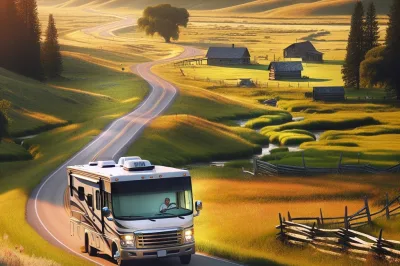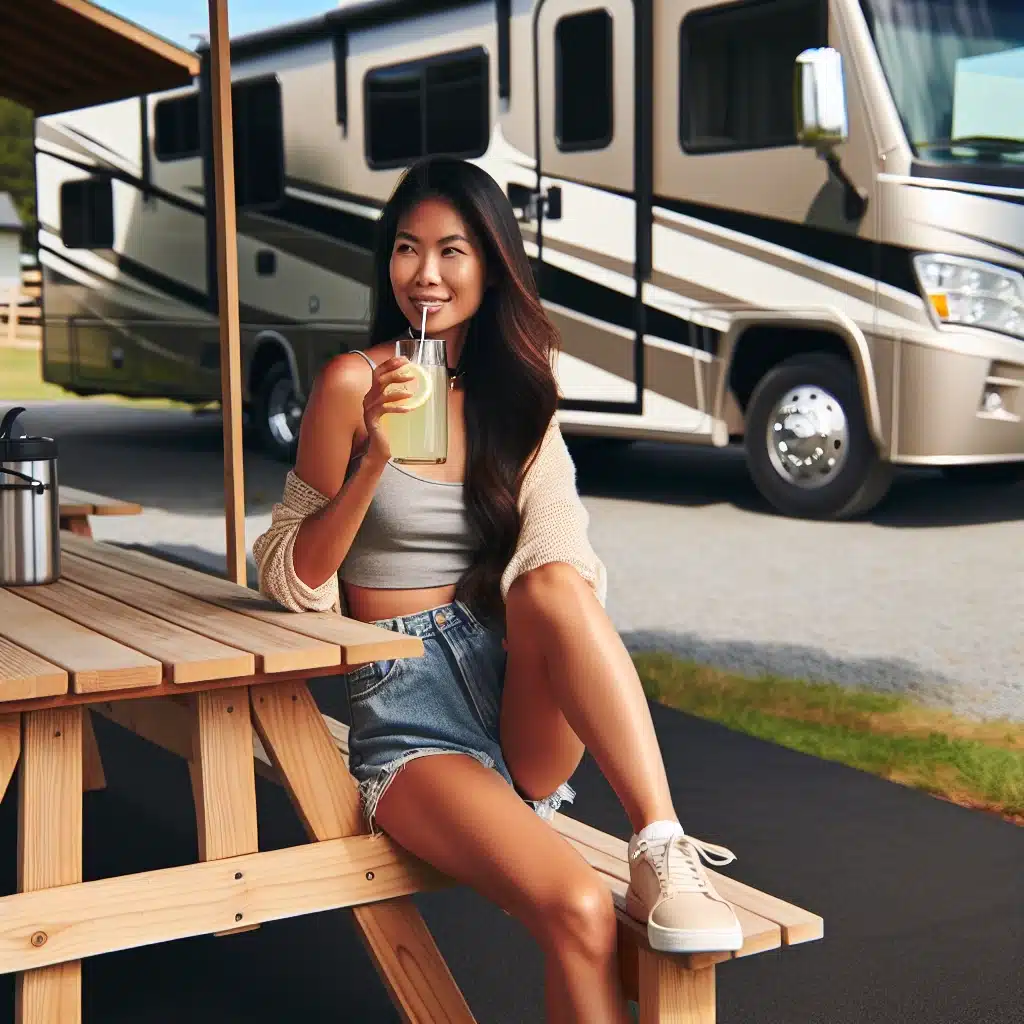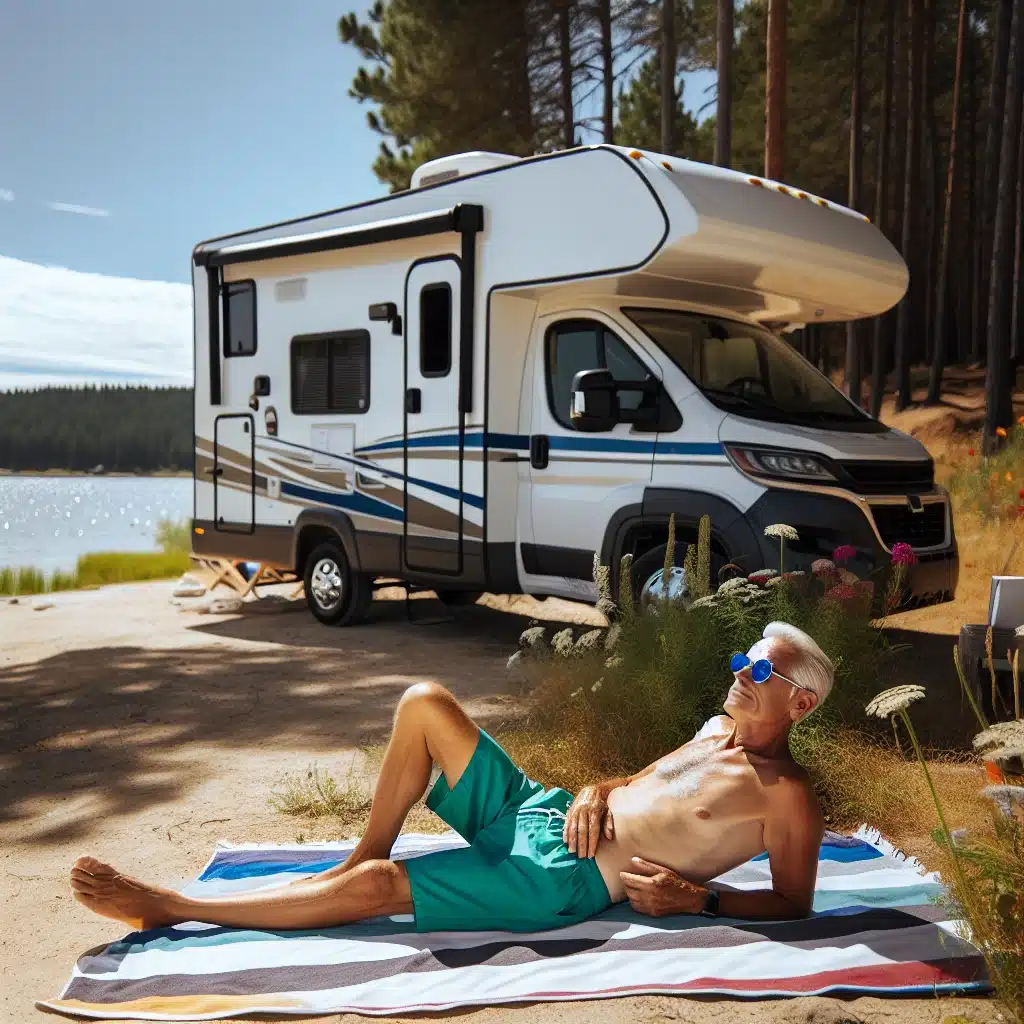Table of Contents

Welcome to the world of RV solar power, where the sun is your fuel station, and the horizon is your limit. If you’ve dreamed of wandering off the beaten path without sacrificing the comforts of home, solar panels are your ticket to energy independence. Let’s illuminate the path to powering your RV with the sun’s endless energy.
The Sunshine Route to Energy Independence
Imagine never having to rely on a campground’s power hook-up or the nearest gas station to keep your lights on and your fridge running. With a solar-powered RV, you create your own power wherever you park. It’s about embracing freedom, saving money, and investing in a sustainable future.
Why Solar is a Game-Changer for Boondocking
Boondocking, or dry camping, is all about enjoying the great outdoors without the constraints of a designated campsite. Solar power elevates this experience by providing you with a reliable energy source, no matter how remote your location. It’s quiet, clean, and, once set up, a free source of power.
Key Takeaways: Harnessing the Sun’s Power
Here are the quick wins you’ll get from this guide:
- Understand how solar panels can free you from the grid.
- Learn the basics of how solar panels work and power your RV.
- Discover the essential components of an RV solar system.
- Find out how to assess your energy needs and choose the right panels.
- Get practical tips on installing and maintaining your solar setup.
Demystifying Solar for Your RV: The Essentials
Solar power might seem complex, but it’s based on simple principles. Sunlight hits the solar panels, gets converted into electricity, and powers your RV’s appliances and devices. The beauty of solar is that it’s scalable. Whether you need to power a few lights or run an air conditioner, there’s a solar solution for you.
Solar Panels 101: How They Power Your Travels
Solar panels are made up of photovoltaic cells that convert sunlight into electricity. This process, known as the photovoltaic effect, is the cornerstone of solar power. The electricity generated is direct current (DC), which can be stored in batteries or converted to alternating current (AC) for everyday use in your RV.
The Core Components of a Solar Setup
To harness solar energy effectively, you’ll need more than just panels. A complete solar setup includes:
- A solar panel array to capture sunlight.
- A charge controller to regulate battery charging.
- Batteries to store energy for later use.
- An inverter to convert DC to AC power.
- Wiring and connectors to tie everything together.
Each component plays a crucial role in ensuring you have a steady, reliable power supply for your off-grid adventures. In the following sections, we’ll explore these components in detail, guiding you through selecting, installing, and maintaining your solar power system.

Picking the Perfect Panels for Your Home on Wheels
Choosing the right solar panels is like picking the best travel companion – they need to match your journey’s demands. The key is to balance your energy needs with the space available on your RV’s roof and your budget. Let’s get started by figuring out how much power you actually use.
Assessing Your Energy Needs on the Road
Before diving into the sea of solar panel options, you need to know your energy consumption. Start by listing all the devices and appliances you use in your RV and note their power requirements. Calculate your daily usage in watt-hours by multiplying each item’s wattage by the number of hours you use it per day. This will give you a ballpark figure of your daily energy needs.
- LED Lights: 10 watts x 5 hours = 50 watt-hours
- Refrigerator: 60 watts x 24 hours = 1,440 watt-hours
- Water Pump: 50 watts x 1 hour = 50 watt-hours
- Laptop: 50 watts x 3 hours = 150 watt-hours
- Phone Charger: 5 watts x 2 hours = 10 watt-hours
Once you have your total, consider adding a buffer of around 20-25% to accommodate for inefficiencies and unexpected usage.
Sifting Through the Solar Panel Styles
With your energy needs in hand, it’s time to choose your solar panels. There are mainly three types to consider:
- Monocrystalline: Efficient and space-saving, but generally the most expensive.
- Polycrystalline: A balance of cost and efficiency, with a distinctive blue hue.
- Thin-film: Flexible and lightweight, perfect for unconventional surfaces, but less efficient.
Think about your travel style, too. Are you a weekend warrior or a full-time nomad? Your duration on the road will influence the size and type of system you’ll need.
Let the Sun in: Installing Your Solar Panels
Installation is a critical step. A well-installed system can last for years, providing free energy wherever you roam. Whether you’re a DIY enthusiast or prefer professional help, understanding the installation process is beneficial.
The Mounting Process: A Step-by-Step Guide
Mounting your solar panels is straightforward if you follow these steps:
- Choose the right location on your RV roof, considering sun exposure and avoiding shadows.
- Ensure the roof is clean and dry before installation.
- Apply sealant to the mounting brackets to prevent leaks.
- Securely attach the brackets to the roof, following the manufacturer’s instructions.
- Mount the panels onto the brackets and tighten all connections.
Remember, safety first! If you’re not comfortable working on your RV’s roof, it’s wise to hire a professional.
Wiring for the Wanderlust: Safe and Secure Connections
Proper wiring is essential for the safety and efficiency of your solar system. Here’s how to wire your panels securely:
- Use the right gauge of UV-resistant solar cable.
- Run cables from the solar panels to the charge controller, ensuring they are well-protected and secured along the way.
- Connect the charge controller to the battery bank, respecting the polarity.
- Install fuses or circuit breakers as close to the battery bank as possible for safety.
- Test the system to make sure everything is working correctly before hitting the road.
Keep in mind, dealing with electrical systems can be dangerous. If you’re not confident in your skills, this is another area where a professional installer can be invaluable.

Efficient Energy Use While Off the Grid
Once you’re soaking up the sun’s energy, using it wisely becomes your mantra. Efficiency isn’t just about having enough power; it’s about stretching every watt to its fullest potential, ensuring your off-grid adventure is never cut short by a drained battery.
Battery Management: Storing Sunshine for Later
Batteries are the heart of your solar system, holding the energy until you need it. The key to effective battery management is understanding your system’s capacity and your consumption pattern. Regularly monitor your battery levels and avoid discharging them below 50% to prolong their lifespan. Use a high-quality charge controller to protect your batteries from overcharging during those long, sunny days.
Conserving Power: Tips for Making Every Ray Count
Conservation is the sidekick of solar power. Here are some power-saving tips:
- Switch to LED lighting, which uses a fraction of the power of traditional bulbs.
- Unplug devices when they’re not in use to prevent phantom power draw.
- Use natural ventilation instead of air conditioning whenever possible.
- Cook outside on a grill to save energy and keep your RV cooler.
- Invest in energy-efficient appliances designed for RV use.
- Charge gadgets during peak sunlight hours to make the most of solar production.
Adopting these habits will help you make the most of your solar investment and enjoy the freedom of off-grid living for longer stretches.
Keeping Your Solar System in Top Shape
Maintenance is the unsung hero of solar power. A well-maintained system can provide you with clean, renewable energy for years to come. Regular check-ups can prevent small issues from becoming big problems.
Regular Maintenance: A Checklist for Solar Health
Here’s a quick checklist to keep your solar system healthy:
- Clean your solar panels periodically to remove dirt, leaves, and bird droppings that can reduce efficiency.
- Inspect all wiring and connections for signs of wear or damage.
- Check the mounting hardware to ensure your panels are secure.
- Review your charge controller’s settings and update them if necessary.
- Test your batteries’ specific gravity (for lead-acid types) or state of charge to gauge their health.
Remember, if you’re ever unsure about performing maintenance tasks, consult a professional. Your solar system’s longevity depends on proper care.
Troubleshooting Common Solar Snafus
Even the best systems can hiccup. Here’s how to handle common issues:
- If your panels aren’t producing power, check for obstructions or shading and ensure all connections are secure.
- A sudden drop in efficiency could mean dirty panels or a fault in the system.
- Battery issues often stem from overuse or undercharging, so monitor your usage and charging cycles.
- Erratic power output could be a sign of a malfunctioning charge controller.
- If your inverter is tripping or not working, check for overload and ensure it’s properly ventilated.
With a bit of know-how and regular care, you can swiftly address these snafus and keep your journey smoothly powered by the sun.
Unveiling the Boundless Benefits of RV Solar Power
Switching to solar isn’t just about energy independence. It’s a move that comes with a suite of advantages that extend far beyond the confines of your RV. From financial savings to environmental stewardship, the perks of solar power create a compelling case for any RVer considering this renewable resource.
The Financial Upsides to Solar Investments
Think of solar panels as a savings account that generates interest in the form of energy. The initial investment might seem steep, but the long-term savings are substantial. Here’s how going solar pays off:
- No more fees for campsite power hook-ups.
- Minimal ongoing costs after the initial setup.
- Increased RV resale value with a modern, eco-friendly upgrade.
- Potential tax incentives and rebates for renewable energy installations.
- The peace of mind that comes from a predictable power source.
Over time, these savings add up, offsetting the cost of your solar system and then some. It’s a smart financial move that also aligns with a lifestyle of freedom and self-sufficiency.
Environmental Impact: Leaving a Cleaner Footprint
Solar power isn’t just good for your wallet; it’s a boon for the planet too. By choosing solar, you’re reducing your reliance on fossil fuels and cutting down on greenhouse gas emissions. Here’s the environmental impact of going solar:
- Decreased carbon footprint from reduced generator and engine use.
- Less noise pollution, preserving the tranquility of natural settings.
- Contribution to a growing movement towards renewable energy sources.
- Support for energy independence and a more sustainable lifestyle.
- Setting an example for others to follow in eco-conscious travel.
Every kilowatt-hour of solar power used is a step towards a cleaner, greener earth. It’s an investment in our planet’s future, one sunny day at a time.
FAQ: Bright Answers to Solar Queries
Got questions? You’re not alone. Here are some of the most common queries about RV solar power, answered to shed light on this illuminating topic.
Can You Power an Entire RV with Solar Panels?
Absolutely! With the right setup, solar panels can power all of your RV’s electrical needs. It’s all about matching your energy consumption with the right amount of solar capacity. Here’s what you’ll need to consider:
– The total wattage of all appliances and devices used in your RV.
– The number of sunlight hours you typically get during your travels.
– The capacity and efficiency of your solar panels and batteries.
– Energy-saving practices to maximize your solar system’s potential.
With careful planning and efficient usage, a fully solar-powered RV is not just possible; it’s a reality for many adventurers.
How Do Cloudy Days Affect Solar Efficiency?
It’s true that solar panels perform best under direct sunlight, but they don’t go on vacation when the clouds roll in. Solar panels can still generate power on cloudy days, albeit at reduced efficiency. Here’s what to expect:
– On average, solar panels produce about 10-25% of their rated capacity under overcast conditions.
– Modern solar panels are designed to capture a broad spectrum of light, including diffuse light on cloudy days.
– Having a robust battery bank ensures you have a reserve of power for those less sunny times.
While solar output will be lower on cloudy days, a well-designed system will keep you powered through. It’s all part of the ebb and flow of living with the rhythms of nature.
What’s the Average Lifespan of RV Solar Panels?
One of the most appealing aspects of solar panels is their longevity. On average, RV solar panels can last between 25 to 30 years before they might need replacing. This lifespan can be influenced by factors such as the quality of the panels, the climate you travel in, and how well you maintain them. Here’s a snapshot of what affects the lifespan:
– Quality of Panels: Higher quality panels tend to have a longer lifespan.
– Environmental Factors: Extreme temperatures and harsh weather can affect longevity.
– Maintenance: Regular cleaning and inspections can extend the life of your panels.
Investing in quality panels and taking good care of them means you’ll enjoy the benefits of solar power for many years to come.
Is It Possible to Install Solar Panels by Myself?
DIY installations are definitely within reach for those who are handy and comfortable with the basics of electrical systems. With the right tools, a good understanding of your RV’s electrical system, and a thorough guide or manual, you can tackle the installation yourself. However, it’s important to consider the following:
– Do you have the necessary tools and safety equipment?
– Are you familiar with the electrical requirements of your RV?
– Can you safely access and work on your RV’s roof?
– Do you have the time and patience to ensure a proper installation?
If you’re unsure about any of these points, it may be best to seek professional help. Safety and reliability are paramount when it comes to your RV’s power supply.
How to Choose Between Portable and Permanent Solar Panels?
When deciding between portable and permanent solar panels, consider your travel habits and convenience needs. Here’s a quick guide to help you decide:
– Portable Solar Panels: Ideal for those who park in the shade or want to optimize sun exposure by moving the panels around. They’re also great for renters or those who switch RVs frequently.
– Permanent Solar Panels: Best for those who want a set-it-and-forget-it solution. They’re mounted on the roof, so there’s no need to set up and break down each time you move.
Think about your typical camping scenarios and choose the option that best fits your lifestyle and energy needs.
In conclusion, stepping into the world of RV solar power is like opening a door to a new dimension of travel. It offers you the freedom to explore without the tether of electrical hookups, the peace of mind that comes with self-sufficiency, and the satisfaction of reducing your environmental footprint. Whether you’re a weekend warrior or a full-time nomad, solar power can revolutionize your RV experience.
As you embark on this solar-powered journey, embrace the learning curve and enjoy the process. You’re not just installing solar panels; you’re investing in a lifestyle that brings you closer to nature and further from dependence on traditional power sources. Here’s to sunny days and starlit nights in your home on wheels, powered by the clean, green energy of the sun.
- Boondocking RVs: Flexible Solar Solutions – 3 March 2024
- Renewable Energy Tips for Full-Time Boondocking RVers – 2 March 2024
- Boondocking Solar Power Systems: Sizing Options & Solutions for Motorhomes – 1 March 2024
